![https://adoptoprod.blob.core.windows.net/article/c3plhkU9kkKTb_6n17YuaQ.png?52]()
How to give negative feedback people will actually want to hear?
If you’re like most managers, you probably hate delivering negative feedback.
You might feel uncomfortable or even worry that you’ll sound like a jerk.
In a study of 2,700 leaders, researchers found that the majority of them avoid giving feedback - especially corrective or negative feedback.
43% of leaders said they found that giving corrective feedback is a “stressful and difficult experience.”
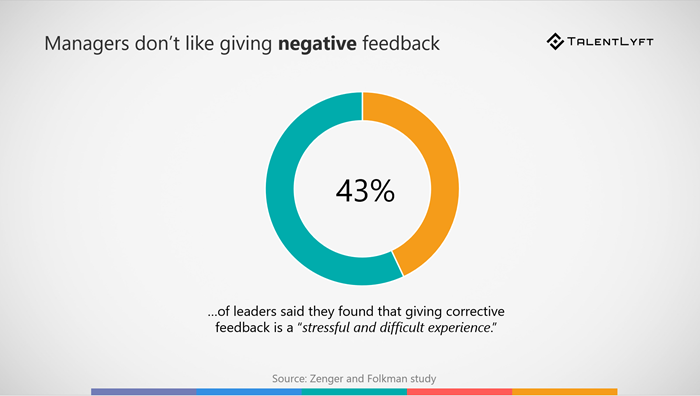
In this blog post, you’ll learn how to deliver negative feedback fairly and effectively.
If given in the right way, negative feedback can be turned into an incredibly powerful tool for increasing employee engagement and productivity.
➡️If you’re looking for more great tips for managing employees, sign up for our FREE 7 days email course: Short Leaderships Tips for Managers!
Employees want to hear negative feedback
Most managers don't enjoy giving feedback, but it seems that employees love receiving it!
The Globoforce study found that:
A global survey conducted by Officevibe compiled data from thousands of organizations across 157 countries worldwide.
Here is what this survey found out:
96% of employees said that receiving feedback regularly is a good thing.
83% of employees really appreciate receiving feedback, regardless if it’s positive or negative!
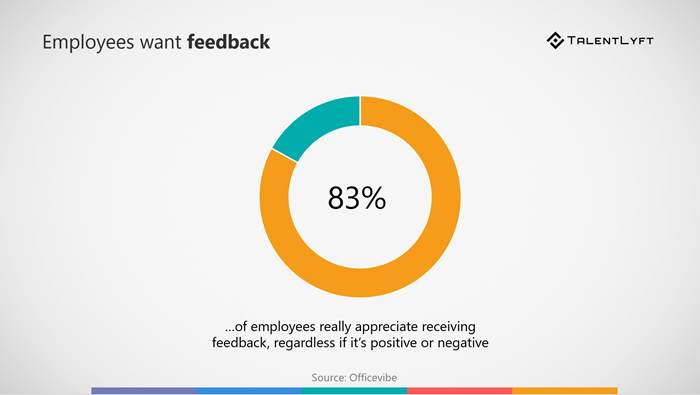
Employees want to hear more feedback - even if that feedback is negative.
A famous Gallup poll found that:
At first, it might seem strange that people are more engaged if they receive negative feedback. But it actually makes sense.
Employees who don’t receive any feedback can feel neglected, unimportant, and like their work goes unnoticed.
Consequently, their engagement will go down the drain.
Employees who get negative feedback at least feel like their work is important.
They also view receiving negative feedback as an opportunity to improve their work performance.
Zenger and Folkman's study has found that:
“Presented well” is the key.
If given in an appropriate manner, negative feedback can provide an opportunity for growth.
Managers who know how to give feedback wisely have an extremely effective tool to manage employees in their hands.
10 best techniques for giving negative feedback
There are many different methods for giving negative feedback.
You’ve probably already heard about the sandwich method.
However, if you want to provide truly useful feedback in a motivating way, you need to move beyond the (shit) sandwich.
Here are 10 better ways to give valuable and constructive feedback to your employees:
Technique #1: I like, I wish, I wonder
This technique is borrowed from the Design thinking (DT) methodology.
The concept is quite simple - you deliver the feedback in 3 steps:
✔️ Step 1: “I like…”
Use this statement to convey the positive aspects of your employee’s work performance.
✔️ Step 2: “I wish…”
Use this statement to share ideas of the aspects of your employee’s performance that can be changed or improved.
✔️ Step 3: “I wonder….”
Use this statement to express your suggestions for improvement.
Here is a real-life example from the Pulse team:
✔️ "I like the layout of the new xyz feature."
🌠 "I wish the text size was slightly larger for better readability."
❓ "I wonder how we will get more people to discover xyz."
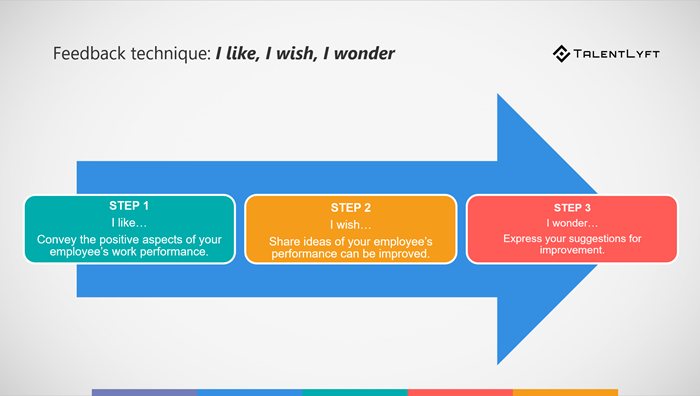
Technique #2: Plussing
Plussing is Pixar's magic formula for giving feedback.
Plussing has played a game-changing role at the film company Pixar.
The general guideline is that you may only criticize an idea if you also add a constructive suggestion. Hence the name plussing.
✔️ Here’s an example:
An animator working on “Toy Story 3” shares her rough sketches and ideas with the director.
Instead of criticizing the sketch, the director will build on the starting point by saying something like: “I like Woody’s eyes, and what if his eyes rolled left?”
Basically, it boils down to the difference between “No, but…” and “Yes, and…”.
In other words, try to build upon what’s already good, and then make suggestions for improvement.
Technique #3: 3-2-1
The 3-2-1 technique is based on research done by psychologists Dr. John Gottman, Dr. Barbara Fredrickson, and organizational psychologist Dr. Marcial Losada.
These researchers have proven that a ratio of at least 3 positive to 1 negative statement is necessary to create a successful relationship in our business lives.
Here is how to deliver feedback using the 3-2-1 technique:
✔️ Step 1: Name 3 things you liked
✔️ Step 2: Name 2 areas you feel could be improved
✔️ Step 3: Highlight the thing you liked most.
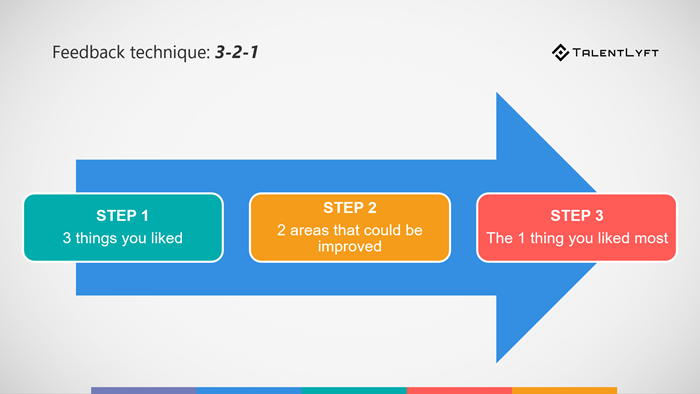
Technique #4: CORE
Core feedback model is created to help you ensure that your negative feedback is specific, concrete, and functional by focusing on the:
✔️ Step 1: Context
When did X occur? Where were you? Who was involved?
✔️ Step 2: Observation
What happened - what specific behaviors did you observe?
✔️ Step 3: Reaction
What was the effect of the employee’s behavior (on you, others and business)?
✔️ Step 4: Expectations
What do you expect from your employees going forward?
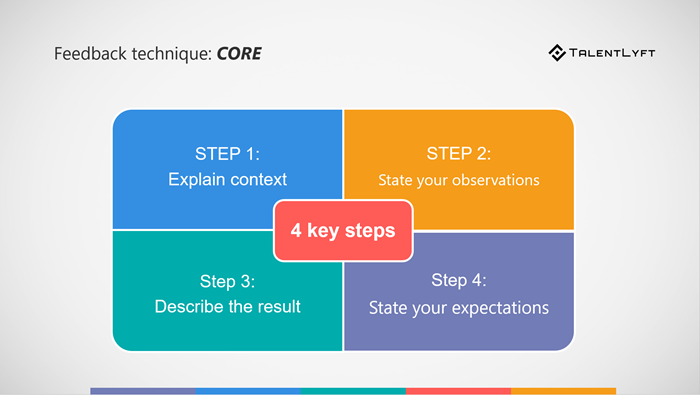
Technique #5: IDEALS
The IDEALS technique is created by Mark Murphy, the author of the famous book about leadership Hundred percenters.
IDEALS technique consists of 6 steps:
✔️ Step 1: Invite
Invite your employees to have a conversation with you.
Give them a choice about when the meeting will take place.
✔️ Step 2: Disarm
Don’t criticize the employee. Stay calm and positive. Focus on the issue at hand.
✔️ Step 3: Eliminate blame
Focus on finding a solution.
✔️ Step 4: Affirm their control
Regularly ask the employee if they agree with what you’re saying
✔️ Step 5: List corrections
List specific recommendations for your employees.
✔️ Step 6: Synchronize
Ask the employee how you can help make sure this doesn’t happen again.
Technique #6: CEDAR
The CEDAR feedback technique was developed by Anna Wildman, a specialist in performance management skills.
The CEDAR technique consists of 5 steps:
✔️ Step 1: Context
Introduce the area of feedback and explain how important it is.
Explain the level of impact; how big it is, who is affected and the outcome.
✔️ Step 2: Examples
Describe specific examples to illustrate the situation clearly.
✔️ Step 3: Diagnosis
Explore what’s behind an employee’s bad performance. This will usually be learning or motivation needs.
✔️ Step 4: Action
Decide what actions will be important going forward.
✔️ Step 5: Review
Follow-up to support and embed any new behaviors is critical.

Technique #7: EEC
Evidence-Effect-Change (EEC) technique comes from project management and it focuses on improvement.
Communication is strictly clinical and intentionally devoid of emotional terms.
EEC technique consists of 3 steps:
✔️ Step 1: Evidence
For example, the project manager corrects a team member for schedule deviations.
The evidence presented is a mix of print-outs, data, and verifiable incidents of inappropriate schedule variation.
✔️ Step 2: Effect
The effect is another print-out that shows concrete cause-and-effect chains brought on by the schedule deviations.
✔️ Step 3: Change
Carefully inquire about the possible ways to achieve the desired change.

Technique #8: Stop, Start, Continue
Stop-Start-Continue is another popular feedback technique, also used by Netflix.
This technique delivers feedback in 3 simple steps:
✔️ Step 1: Stop
Tell your employees what you feel they should stop doing.
✔️ Step 2: Start
Tell your employees what you feel they should start doing.
✔️ Step 3: Continue
Tell your employees what you wish them to continue doing.

Technique #9: SBI
Developed by The Center for Creative Leadership, the Situation-Behavior-Impact (SBI) technique outlines a simple process that you can use to give feedback:
✔️ Step 1: Identify the situation
Put the feedback into context and gives an employee a specific setting as a reference.
For example: “At the client meeting on Monday afternoon...”
✔️ Step 2: Describe the behavior
Describe the specific behaviors that you want to address.
For example: “When you gave your presentation, you were uncertain about two of the slides, and your sales calculations were incorrect.”
✔️ Step 3: Explain its impact
Use “I” statements to describe how the employee’s action has affected you or others.
For example: “I felt embarrassed because the entire board was there. I’m worried that this has affected the reputation of our team.”
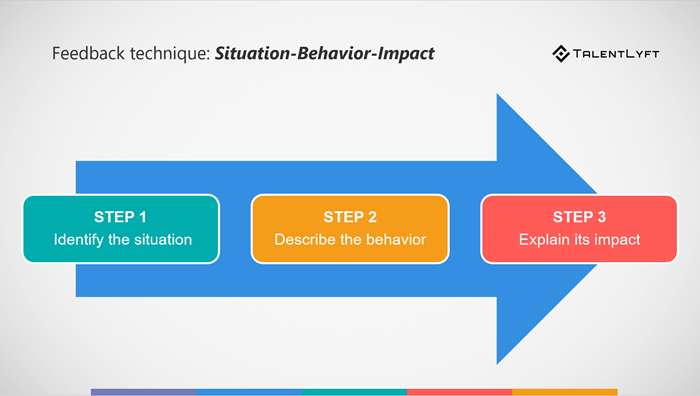
Technique #10: 6 steps
Here is how to give feedback using 6 steps technique:
✔️ Step 1: State the constructive purpose of your feedback.
For example: "I have a concern about...", "I feel I need to let you know..."
✔️ Step 2: Describe specifically what you have observed
For example: "Yesterday afternoon, when you were speaking with Mrs. Sanchez, I noticed that you kept raising your voice."
✔️ Step 3: Describe your reactions.
For example: "The staff member looked embarrassed and I felt uncomfortable about seeing the episode."
✔️ Step 4: Give the other person an opportunity to respond
For example: "What do you think?","What is your view of this situation?"
✔️ Step 5: Offer specific suggestions.
For example: "Jennifer, I sometimes write myself notes or put up signs to remind myself to do something."
✔️ Step 6: Summarize and express your support
For example: "As I said, the way the group has figured out how to cover phone calls has really lessened the number of phone messages to be returned. You've really followed through on a tough problem. Please keep taking the initiative on problems like that.”
Which negative feedback technique should you use?
Unfortunately, there is no single best technique for giving negative feedback.
Feedback isn’t one-size-fits-all - especially when it comes to giving negative feedback.
You should choose the one that fits best with your company culture and your own, personal management style.
A good idea is to experiment and try out a few techniques.
The more of them you master, the more equipped you’ll be for giving feedback to different employees.
Key takeaway: Tailor your feedback to the recipient!
You should always keep in mind that different ways of giving negative feedback can have a completely different impact on different people.
A technique that works great with some of your employees may be completely wrong for other employees.
This is why it is crucial for you to tailor your feedback to the specific recipient. Get to know your team members.
If you work closely with them every day, you probably know how they handle certain situations. Use that insight to choose the approach that might be right for them.
For example, if you’re dealing with an employee who is a sensitive perfectionist, a very subtle remark from your side might be more than enough.
On the other hand, a self-confident, star performer might prefer to hear very direct and honest negative feedback.
Generally, you should always keep in mind your employees’ expert level.
A recent research paper, “Tell Me What I Did Wrong: Experts Seek and Respond to Negative Feedback,” published in The Journal of Consumer Research has found that expertise plays a huge role in the way people react to feedback.
When people are experts on a subject (or consider themselves experts!), they’re more eager to hear negative feedback, while beginners are more likely to seek positive responses and encouragement.
If you don’t know your team members that well, ask them how they prefer to receive feedback.
Here is what you can say:
“I would like to offer you regular feedback that will help you learn and grow. Can you teach me how to give you feedback that will motivate you?”
You might be surprised how many valuable guidelines such a simple question can provide.
When you approach your employees this way, you’re telling them that you have their best interests at heart.
You are letting them know that you’ll be on their side - even when you give them negative feedback.
Give solely positive feedback as well!
In order to build trust with your employees and ease the whole process of delivering negative feedback, you should also deliver solely positive feedback to your employees regularly.
Keep in mind that the Zenger and Folkman study found that:
Frequently asked questions
What makes negative feedback effective for employee growth?
Negative feedback, when delivered appropriately, can significantly improve employee engagement, motivation, and performance, turning it into a powerful tool for personal and professional development.
How does the 'I like, I wish, I wonder' technique work?
This technique involves a three-step process of positive feedback ('I like'), constructive criticism ('I wish'), and suggestive inquiry ('I wonder'), aiming for a balanced and constructive conversation.
What is the concept of 'Plussing' in feedback?
'Plussing' is a technique used by Pixar, focusing on building upon what's already good in an idea or performance and making suggestions for improvement, promoting a positive and constructive feedback environment.
What's the importance of the 3-2-1 feedback technique?
The 3-2-1 technique emphasizes providing three positive comments, two areas for improvement, and highlighting one aspect particularly well done, maintaining a positive ratio in feedback delivery.
How does the Situation-Behavior-Impact (SBI) technique help in giving feedback?
The SBI technique helps structure feedback by focusing on a specific situation, describing the observed behavior, and explaining its impact, making the feedback clear and actionable.
























